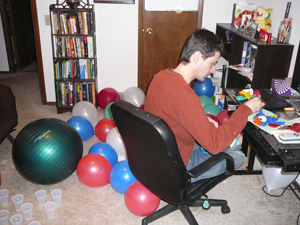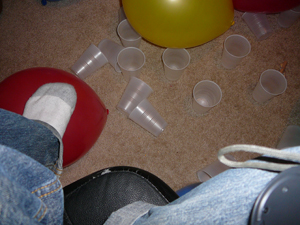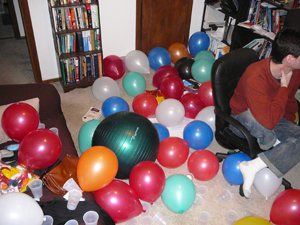What it's like to be Yeast
by Andrew Peck
I am surrounded by my own waste.
In a sense, this is always true—sweat beads and skin flakes. Today, however, I struggle to be comfortable in my computer chair. The waste is bigger, more pronounced, and more deliberate. It fills my small office, making the little room look like a carnival and smell like a hospital. Latex balloons filled with carbon dioxide dance atop a layer of clear plastic cups. Below my desk, my legs twist and bend trying to find comfortable footing. Throughout the day my environment has grown increasingly claustrophobic and bespoiled; yet, if I am to survive, this must be so.
I certainly cannot comfortably go about my day without eating, and, as per the rules of the experiment in which I am engaging, such an action merits a reaction. Each time I consume food or take a drink, I make a material change in the room around me. The goal is to simulate the relationships between the principle non-human entities used in the brewing of alcohol.

My office is my bottle, oxygen is my medium, and just as yeast creates carbon dioxide and ethanol as it metabolizes sugar, I blow up a balloon and place a plastic cup on the floor each time I take a bite of food or sip a drink. My coffee addiction takes up most of the futon.

This mess is an act of carpentry. As Ian Bogost writes, “carpentry entails making things that explain how things make their world” (93). In other words, engaging in an act of carpentry means creating something that simulates the experience of a non-human entity. My act of making is an experiment which, in turn, begs that I continually remake my surroundings in order to better understand the churning vat of mead that sits in my pantry.
When yeast consumes sugar, it creates ethanol and carbon dioxide. These byproducts are necessary evils—if the yeast is to survive, it simply must continue to consume glucose. However, as it expels more and more waste, its living space becomes less and less hospitable. Yeast thrives in aerobic environments, but the increased prevalence of carbon dioxide inhibits the lifecycle of a colony. Yeast can live in somewhat alcoholic environments, but even the most hearty strains of wine yeast die out once the alcohol concentration hits 18 to 20 percent—any spirit beyond that must be distilled. The more yeast thrives in an enclosed space, the more it threatens its own survival. Today, I am yeast, and it is this feeling of claustrophobia that I seek to replicate.
I begin the day with a clean office. Breakfast, a bowl of shredded wheat, takes 17 bites to consume. Coffee: five gulps. By noon, over twenty balloons are inflated and almost two dozen cups placed out. Like the ethanol, I treat the high concentrations of plastic cups as something to be avoided, on several occasions narrowly missing toppling the cups like dominoes with an errant step. Tired from the energy of blowing up the balloons, I slump in my chair (careful not to lean back for fear of popping a nearby balloon) and think about the way I have been consuming food for years.


My consciousness enters the picture. A few hours in, I become reticent to eat anything because of the work and mess it entails. I am judicious about my afternoon snack of graham crackers, downing the two wafers in just over a dozen bites. For a moment, it strikes me that this is perhaps the one thing that inexorably separates me from the yeast. I have the higher reasoning functions, the self-preservation instinct to reach equilibrium with my surroundings. The inconvenience of even small movements saps my will to work. My office is never this messy.
Then it hits me: this is more than balloons or skin flakes. Oil and exhaust, potato chips and mercury, hand sanitizer and wrapping paper. I do this. Every day, without fail, I do exactly this. And, what's worse, I have to do this. I create waste because it is the price of survival. My office may never be less than immaculate, but I have befouled the offices of many other entities through my actions. My bottle is more vast—2.9 x 1023 greater in volume, to be exact—but it is not infinite. I begin to realize that I'm not that far removed from the yeast when time and scale are reapportioned appropriately.
Oh, how cross that one most perspicacious flake of yeast must be with the rest of his colony! If only he could tell them “Stop! Wait! We need to be more careful! We need to ration! We need to be responsible!” But he lacks such communication. Even if he had the gift of speech, perhaps the end is inevitable. After all, the rest of the colony would then be able to listen, understand and respond. Arguments would erupt. “Every fungus for itself,” they might respond, “survival of the fittest.” Others may sympathize but feel powerless, offering the iconoclastic cell a resigned grin and a “Not in my backjar.” This is an argument without an answer. Communication is not a panacea, and there is no such thing as perpetual motion. Death is the price of living. Biochemistry ensues.
Dinner is a somber affair. I finish my corned beef on multi-grain in a record-breaking six bites.

I am subsisting now, not enjoying. I wish I could say some eleventh hour revelation makes everything OK again or that some last minute bit of perspective helps me come to terms with a universe I am finding increasingly small, but none occur. Just a few pictures to catalog the clutter of my day and some sympathy for a microscopic lifeform. The only solace I can find is this: In the end, yeast dies as the result of making something that brings joy to others. We should all be so lucky.